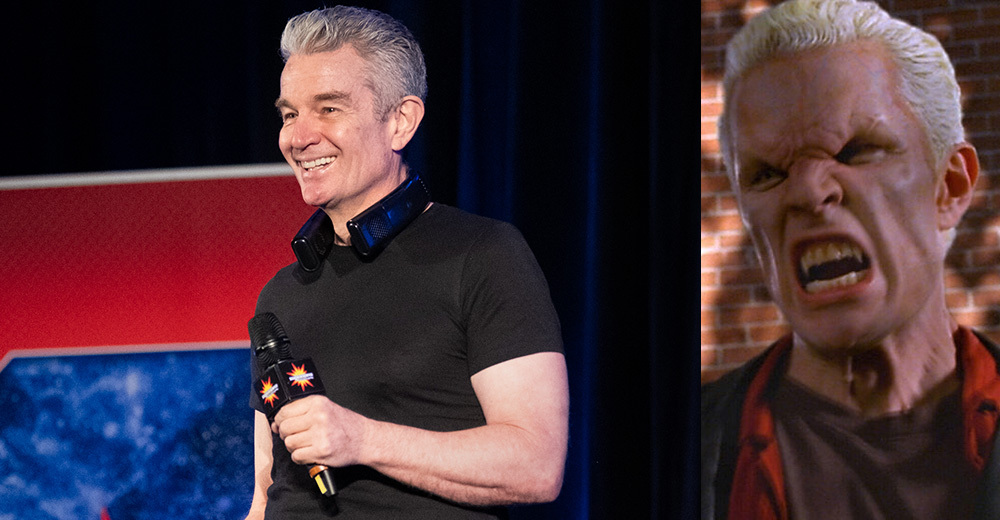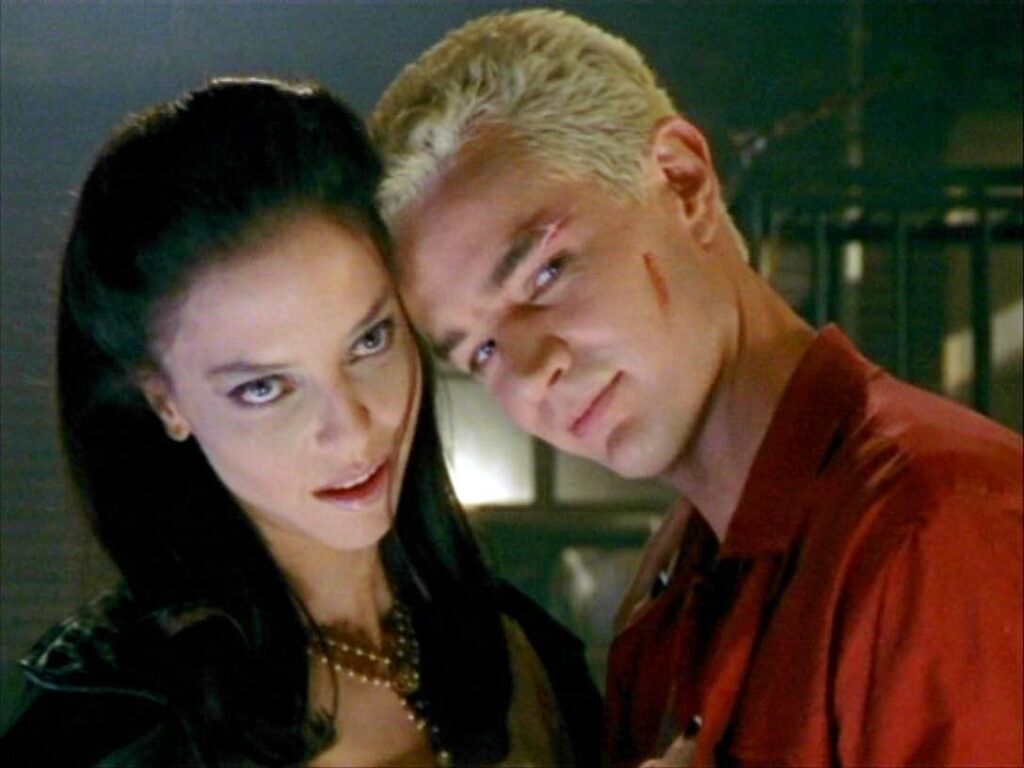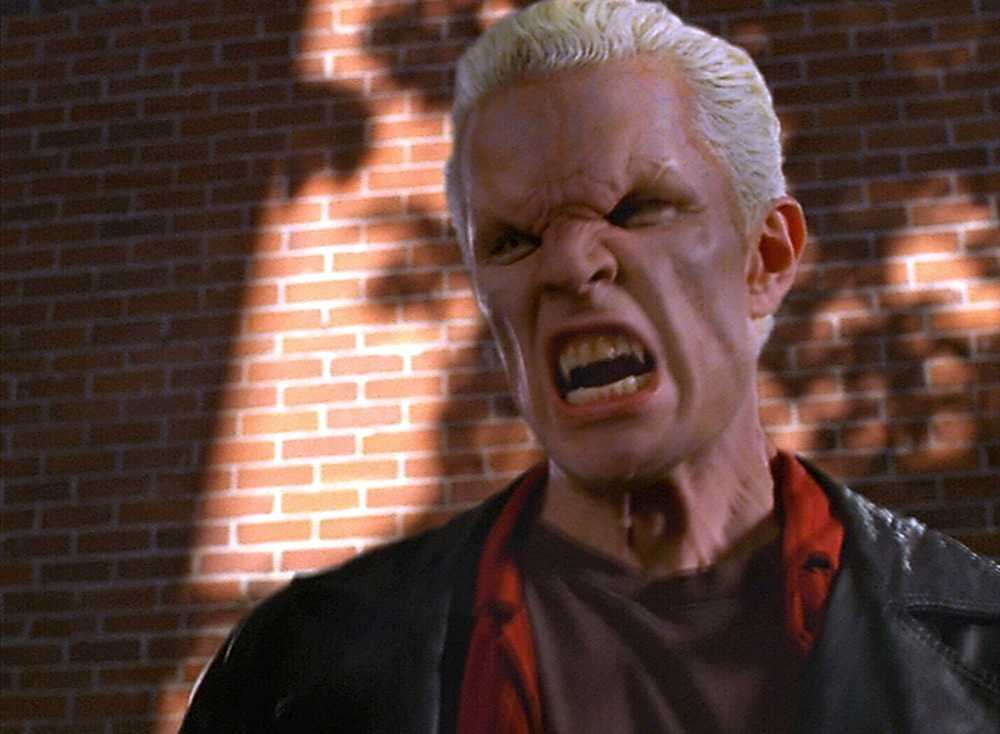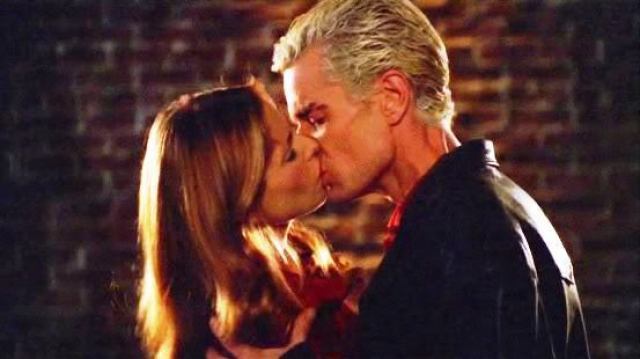
Buffy the Vampire Slayer was a cultural phenomenon that redefined television for a whole generation. With its mix of wit, horror and compelling drama, interwoven with some expertly crafted storytelling, this show used the supernatural and surreal to explore very real themes.
Over the course of seven seasons, plus five seasons of spin-off show Angel, Buffy introduced fans to a roster of well-written and endearing characters. However, one of the Buffyverse’s biggest breakout stars was never meant to last more than a few episodes. Introduced as one of the ‘Big Bads’ for Season Two, the platinum-haired punk-rock vampire Spike, played by Sydney and Perth Supa-Star James Marsters, was slated to be killed off fairly quickly. But, he went on to become not only one of the show’s most popular characters, but one of its most important too, with one Hell of a character arc. (It should go without saying, but spoilers lie ahead.)
Buffy, and by extension Angel, had some of the greatest character development in the history of TV. The likes of Cordelia and Wesley ended up being so far removed from their initial divisive characterisations, that they were practically different people. Spike went through a similar, although much more subtle journey. He was introduced early in the show’s second season, along with his vampiric sire and long-time lover Drusilla, forming something of a chaotic power couple.
Spike’s attitude and tone are established from his very first moment on screen. A rock song plays as a car crashes through the ‘Welcome to Sunnydale’ sign, before the camera pans up, slowly revealing a figure in a long black coat stepping out of the vehicle, settling on Spike’s vamped out face. The stage was set – this guy was as cool and hardcore as they come.
 However, it didn’t take long for viewers to see that Spike was actually quite multifaceted. In many ways he was pretty sensitive and even a bit of a hopeless romantic. He was desperately devoted to Drusilla, their passion still boiling after more than a century together. In fact, ‘passion’ may be Spike’s defining character trait. Whether it be his penchant for killing Slayers, or his twisted romantic displays, Spike is a slave to his passions. Love or hate, depression or desire; his emotions are never far from the surface.
However, it didn’t take long for viewers to see that Spike was actually quite multifaceted. In many ways he was pretty sensitive and even a bit of a hopeless romantic. He was desperately devoted to Drusilla, their passion still boiling after more than a century together. In fact, ‘passion’ may be Spike’s defining character trait. Whether it be his penchant for killing Slayers, or his twisted romantic displays, Spike is a slave to his passions. Love or hate, depression or desire; his emotions are never far from the surface.
It makes sense when you consider that he was a poet in his mortal life. This mix of punk and passion made him an instant hit with fans, so much so that despite originally being planned to die midway through the second season, he lived to fight another day.
Spike made a single appearance in Season Three, but Season Four was when he settled in as a core member of the cast. However, he felt lost during this time, both in the show’s narrative, and the metanarrative. Brought back due to the character’s popularity, the writers clearly took some time to figure out his new purpose among the players.
On top of that, they had to devise a way to make a notorious mass-murdering monster a main character. The solution was to have him implanted with a behavioural control chip by the government demon-hunting organisation, The Initiative. It caused Spike to experience crippling pain whenever he attempted violence against humans, effectively neutering him and making him less of a threat and more of a sassy frenemy to the Scoobies.
With demons being the only things he could still hurt, it also gave him a reason to help the gang on occasion, though he still displayed antagonistic tendencies. Marsters himself has said that he was brought on in Season Four to replace Cordelia, who had moved over to Angel, as the abrasive character who criticises the rest of the gang, however that quickly became redundant, with former vengeance demon Anya filling the same role.
 Season Four Spike is a character in crisis, slipping into depression as he desperately tries to regain the power he once had. The once feared “William the Bloody” who spent more than a century sowing carnage across Europe, had been defanged and left sulking around a crypt or bunking in Xander’s basement. He became a bit of a joke, bemoaning the fact that he wasn’t scary anymore.
Season Four Spike is a character in crisis, slipping into depression as he desperately tries to regain the power he once had. The once feared “William the Bloody” who spent more than a century sowing carnage across Europe, had been defanged and left sulking around a crypt or bunking in Xander’s basement. He became a bit of a joke, bemoaning the fact that he wasn’t scary anymore.
It’s only when he found he could still hurt demons that he gained a new lease on life, but he never gave up on getting his chip removed. Season Four in general was one of transition, but this was truer for Spike than most.
That transition was completed in Season Five, one of the show’s greatest, where something fascinating happened to Spike. He attempted to get his chip removed early in the season, but it failed miserably, leading to another humiliating butt-kicking from Buffy. Spike was understandably furious, left feeling humiliated and dejected; his goal now further away than ever before.
Yet, that episode ends with Spike waking up in shock in the middle of a rather steamy dream involving the slayer. Thus Spike’s new role on the show was revealed: a love interest for Buffy. Over the course of the season, we see Spike growing increasingly infatuated with Buffy, even going so far as to commission the creation of a ‘Buffybot’ robot in her likeness.
By the end of Season Five Spike was doing whatever he could to get in Buffy’s good books, even taking her little sister, Dawn, under his wing. Then, in a striking and gut-wrenching moment, when Buffy dies in the final moments of the season, Spike actually drops to his knees, bawling, seemingly far more affected than any of the Scoobies.
 Season Six is when Buffy and Spike’s relationship reaches its toxic, uncomfortable-to-watch crescendo. What had previously been either fun and silly or weirdly endearing, suddenly grew very dark. Buffy was a very different person after being brought back from the dead and the entire sixth season is a masterclass in using fantasy to explore themes of trauma.
Season Six is when Buffy and Spike’s relationship reaches its toxic, uncomfortable-to-watch crescendo. What had previously been either fun and silly or weirdly endearing, suddenly grew very dark. Buffy was a very different person after being brought back from the dead and the entire sixth season is a masterclass in using fantasy to explore themes of trauma.
Disconnected from her friends and suffering PTSD and depression, Buffy finds that Spike is the only person who can really get what she’s been through. Thus begins a torrid and illicit ‘relationship’ that is less about romance for Buffy and more about thrill-seeking. Spike, on the other hand, seems to genuinely care for Buffy and he even claims to love her. Whether or not a soulless vampire is capable of love is debatable, but he certainly believes it to be true.
Naturally, it doesn’t end well, and not only do both characters get hurt, but they both go through a crucible, coming out the other side the better for it, even if not immediately obvious. In Spike’s case, this sends him on a quest for redemption which shockingly leads to him regaining his soul.
This is truly the greatest moment in Spike’s journey, and as is often the case, he had to reach his lowest point to get there. He made the choice to be better, to regain his soul in the hopes he could become the kind of man Buffy deserved. Unlike Angel, who had his soul forced back onto him, Spike sought it out, even if he had to go through Hell to get it.
Going into the seventh and final season, Spike is a mess again. Despite regaining his soul, he is more lost than ever, his mind in complete disarray thanks to his newfound guilt for his past sins. However, over the course of the season, he and Buffy become closer than they’d ever been, just not in the same way as they’d attempted before.
Buffy gets put through the wringer in that final season as she faces her biggest threat to that point, The First Evil, while also having to mentor a whole new generation of potential slayers. By the back half of the season, she becomes increasingly isolated from her friends, to the point where her leadership falls into question and she is essentially kicked out from her own home.
 Amid all this, the one person who stands by her side, even to his detriment, is Spike. What had once been passionate hatred or desire, by now had given way to something softer. Calmer. Deeper. Something approaching genuine affection and respect. One of the greatest moments between Buffy and Spike in the entire show comes here, when Spike spends the night comforting Buffy when she’s at her lowest. Not pursuing her or trying to prove himself – just holding her and being there for her when she needed it.
Amid all this, the one person who stands by her side, even to his detriment, is Spike. What had once been passionate hatred or desire, by now had given way to something softer. Calmer. Deeper. Something approaching genuine affection and respect. One of the greatest moments between Buffy and Spike in the entire show comes here, when Spike spends the night comforting Buffy when she’s at her lowest. Not pursuing her or trying to prove himself – just holding her and being there for her when she needed it.
This all leads up to Spike’s final act of redemption in the series finale, when he sacrifices himself in order to enact the Scoobies’ final plan to defeat The First. His final exchange with Buffy is as poignant as it is heartbreaking. Buffy declares her love for him, only for him to smile as he responds, “No you don’t. But thanks for saying it.”
He no longer desires her or longs for her affection. The soulless monster has learned to genuinely love her, and is willing to make the ultimate sacrifice for her. And of course, he takes the ‘Welcome to Sunnydale’ sign with him.
Spike’s arc on Buffy the Vampire Slayer is as close to perfect as you could get, and it ends on a beautiful note. And yes, he was resurrected for Angel’s fifth and final season, but this in no way undermined his character arc. It’s more of a coda, exploring what happens after the sacrifice, and whether he can still be a good man when Buffy’s not around.
If anything, Angel Season Five – a masterpiece of television in its own right – serves to cement Spike’s new status as a champion. His long and winding redemption arc comes to a head in an alleyway one rainy night, standing alongside his Angel Investigations allies as they face down the literal hordes of Hell.
After sacrificing himself to save the world once, he’s ready to go and do it again. Because in the Buffyverse, especially in Angel, there aren’t any rewards. The battle never ends. Ultimately, his journey culminates not in glory, but in another act of self-sacrifice. Could it have ended in any other way?
Spike is one of the most complex and interesting characters of modern fiction, with one of the greatest character arcs of all time, and watching it unfold is a thing of beauty. One of Buffy’s biggest enemies became her greatest supporter; a bloodthirsty monster became a selfless champion. And to think, they were going to kill him off after only a few episodes.
Meet James Marsters at Supanova in Sydney (22-23 June) and Supanova in Perth (29-30 June).
Lead image: James Marsters at Supanova 2024 – Sydney. Photo by Ewan Ly









